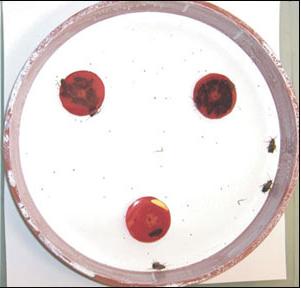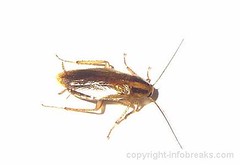 As some of you know, I live with a large group of cockroaches that boldly infest my apartment, along with those of all my neighbors. Call me crazy, but it always seemed to me that the smaller, more numerous, German cockroaches, Blattella germanica, made decisions together, or they appeared to at least consult with each other before hauling off my refrigerator as a well-organized team. But several scientists confirmed my suspicions today when they published their research suggesting that cockroaches are democratic group thinkers.
As some of you know, I live with a large group of cockroaches that boldly infest my apartment, along with those of all my neighbors. Call me crazy, but it always seemed to me that the smaller, more numerous, German cockroaches, Blattella germanica, made decisions together, or they appeared to at least consult with each other before hauling off my refrigerator as a well-organized team. But several scientists confirmed my suspicions today when they published their research suggesting that cockroaches are democratic group thinkers.
Cockroaches cannot communicate vocally, but it's known that they are very sensitive to chemical and tactile cues -- so much so that they can identify each individual's home colony simply by touching antennae. Antennae touching allows the insects to learn about each other through interpreting each other's chemical cues, similar to butt-sniffing in dogs.
 José Halloy, a co-author of this study, tested the insects' decision-making abilities by placing them into an enclosure containing three shelters (pictured, above). He then documented how the cockroaches divided themselves up between the shelters. After frequent antenna probing, touching and other interactions, the cockroaches divided themselves up perfectly within the shelters. For example, if 50 insects were placed in a dish with three shelters, each with a capacity for 40 bugs, 25 roaches huddled together in the first shelter, 25 gathered in the second shelter, while the third was left vacant.
José Halloy, a co-author of this study, tested the insects' decision-making abilities by placing them into an enclosure containing three shelters (pictured, above). He then documented how the cockroaches divided themselves up between the shelters. After frequent antenna probing, touching and other interactions, the cockroaches divided themselves up perfectly within the shelters. For example, if 50 insects were placed in a dish with three shelters, each with a capacity for 40 bugs, 25 roaches huddled together in the first shelter, 25 gathered in the second shelter, while the third was left vacant.
But when Halloy and his colleagues changed this setup such that there were three shelters, each with a capacity to house more than 50 insects, they found that all of the cockroaches moved into one house together.
This research shows that a balance exists in cockroach society between cooperation and competition for resources.
Halloy explained that "cockroaches are gregarious insects (that) benefit from living in groups. It increases their reproductive opportunities, (promotes) sharing of resources like shelter or food, prevents desiccation by aggregating more (humidity-conserving bodies) in dry environments, etc. So what we show is that these behavioral models allow them to optimize group size."
This research was published this week in the top-tier journal, Proceedings of the National Academy of Sciences.
Thanks, Dawn!
- Log in to post comments


Fascinating! Related:
http://www.duke.edu/philosophy/bio/assets/team_agency.pdf
http://www.duke.edu/philosophy/bio/assets/evol_group_action.pdf
After living overseas with these creatures, I find all this very spooky!
Any sci-fi channel B-movies with social cockroaches in the making?
As a gratuity I pass on my favorite roach-control system, proved over and over in the hot, humid, and buggy environs of Houston: 1 part cornmeal to 1 part boric acid powder. Dead roaches will be seen everywhere. Place in shallow containers along walls, in corners, and in enclosed spaces under sinks.
I recently took a wide mouth fruit jar and put about 3 tbsp of used coffee grounds, about a half cup of water and placed the jar outside the house against the wall and inspected the jar a couple days later. There were about 30 dead roaches inside. That worked well so I placed several more jars in strategic areas and behold! it worked again. It appeared that they either drowned or were poisoned by the coffee.